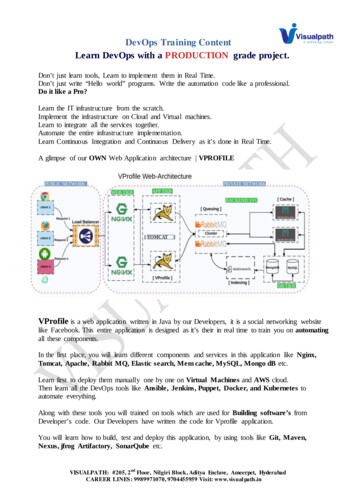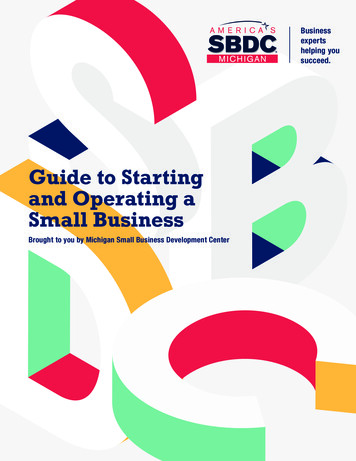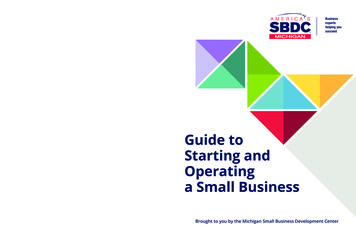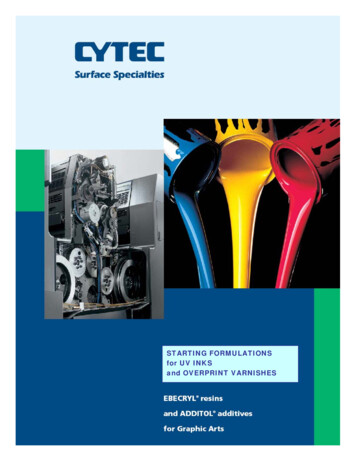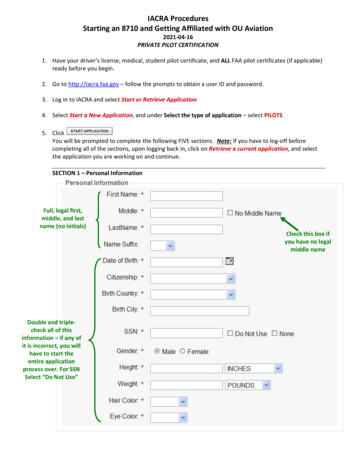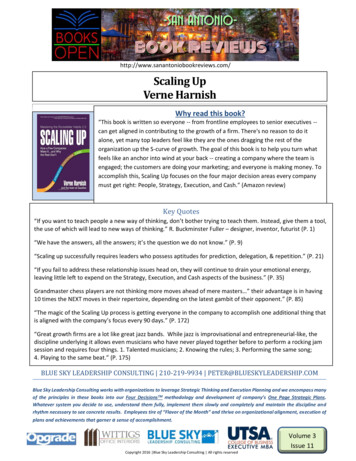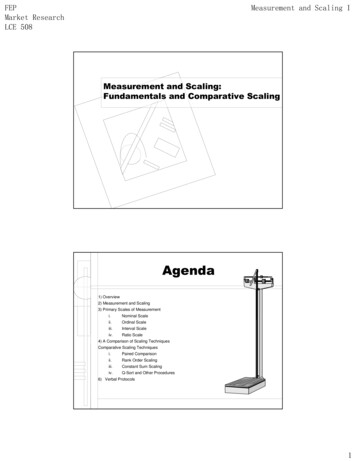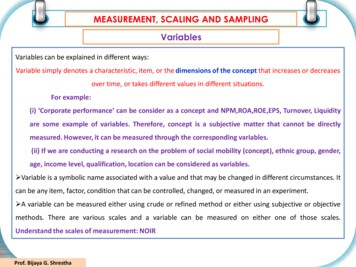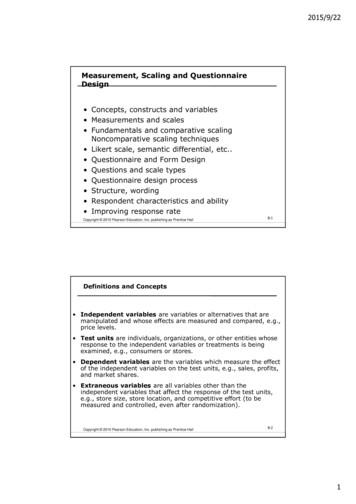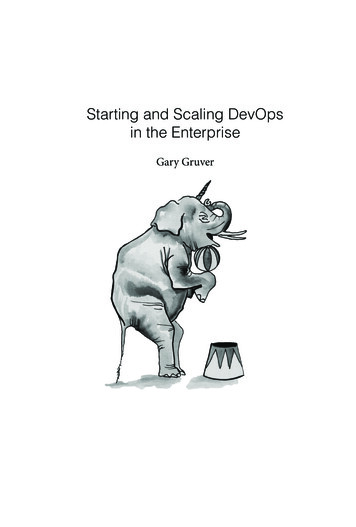
Transcription
Starting and Scaling DevOpsin the EnterpriseGary Gruver
Copyright 2016 Gary GruverPrint ISBN: 978-1-48358-358-7eBook ISBN: 978-1-48358-359-4All rights reserved.Elephant pictures by Amelia TiedemannGraphics by Shahla Mahdavi and Cassie Lydon of Katie Bush design
TABLE OF CONTENTSAbout the Author 1Acknowledgments 3Forward 5Chapter 1 - DevOps and the Deployment Pipeline 7Chapter 2 - The Basic Deployment Pipeline 17Chapter 3 - Optimizing the Basic Deployment Pipeline 25Chapter 4 - Scaling to a Team with Continuous Integration 46Chapter 5 - Scaling Beyond a Team 51Chapter 6 - Scaling with Loosely Coupled Architectures 58Chapter 7 - Documenting the Deployment Pipeline for TightlyCoupled Architectures 64Chapter 8 - Optimizing Complex Deployment Pipelines 69Chapter 9 - Practices for Tightly versus Loosely CoupledArchitectures 82Chapter 10 - The Impact of Moving to DevOps in Larger, MoreComplex Organizations 90Bibliography 93
1ABOUT THE AUTHORGary Gruver is an experienced executive with a proven track recordof transforming software development and delivery processes inlarge organizations, first as the R&D director of the LaserJet firmware group that completely transformed how they developedembedded firmware and then as VP of QA, Release, and Operationsat Macy’s.com where he led the journey toward continuous delivery.He now consults with large organizations and runs workshops tohelp them transform their software development and delivery processes. He is the co-author of Leading the Transformation: ApplyingAgile and DevOps Principles at Scale and A Practical Approachto Large-Scale Agile Development: How HP Transformed LaserJetFutureSmart Firmware.Website: GaryGruver.comTwitter: @GRUVERGaryLinkedin: https://www.linkedin.com/in/garygruverEmail: gary@garygruver.com
3ACKNOWLEDGMENTSMany people have contributed to this book. I would like to thankeveryone I have worked with over the years who helped me betterunderstand how to develop software. The ideas shared in this bookare an accumulation of everything I have learned from working witheach of you on a constant journey of improving software development processes. Without these discussions and debates, my understanding would not be as rich and the book would not be as complete.I would like to especially thank all the clients of the executive andexecution workshops for letting me join you on your journey.Sharing the challenges you were facing and the improvements thatworked helped to fine tune the content of this book. Thanks also toPaul Remeis and Greg Lonnon for helping to fine tune the content byhelping me deliver and improve the execution workshops.I would like to thank everyone that has taken time to give me feedback on early versions of the book (in alphabetical order): JohnEdiger, Mirco Hering, Jez Humble, Tommy Mouser, and VinodPeris. Your input significantly improved the final product.I would also like to thank the editorial and production staff: KateSage, the editor, did a great job of forcing me to clarify the ideasso they could be communicated clearly and concisely. The back andforth made for a better book, but more importantly it required meto crisp up the concepts, enabling me to be more efficient at helpingothers on their journeys. Shahla Mahdavi and Cassie Lydon fromKatie Bush design provided most of the graphics. They did a greatjob if creating visual artifacts to help communicate the ideas I amtrying to get across. Finally, I would like to thank Amelia Tiedemannfor the wonderful elephant pictures and cover design. I feel she wasreally helpful in communicating that a successful DevOps transformation requires more than just having all the right parts.
5FORWARDWhen David Farley and I wrote the Continuous Delivery book, wethought we were tackling a dusty, niche corner of the software delivery lifecycle. We didn’t expect a huge amount of interest in the book,but we were sick of seeing people spending weeks getting buildsdeployed into testing environments, performing largely manualregression testing that took weeks or months, and spending theirnights and weekends getting releases out of the door, often accompanied by long outages. We knew that much of the software deliveryprocess was hugely inefficient, and produced poor outcomes in termsof the quality and stability of the systems produced. We could alsosee from our work in large enterprises that the tools and practicesexisted that would remove many of these problems, if only teamswould implement them systematically.Fortunately, we weren’t the only ones who saw this. Many others—including Gary—had come to the same conclusion across theworld, and the DevOps movement was born. This movement hashad unprecedented success, primarily because these ideas work. AsI’ve worked with leaders in large, regulated companies, and mostrecently as a US federal government employee at 18F, I’ve seen orderof magnitude improvements in delivery lead times accompanied byimprovements in quality and resilience, even when working withcomplex, legacy systems.Most important of all, I’ve seen these ideas lead to happier technology workers and end users. Using continuous delivery, we canbuild products whose success derives from a collaborative, experimental approach to product development. Everybody in the teamcontributes to discovering how to produce the best user and organizational outcomes. End users benefit enormously when we can workwith them from early on in the delivery process and iterate rapidly,
6 STARTING AND SCALING DEVOPS IN THE ENTERPRISEchanging the design of systems in response to their feedback, anddelivering the most important features from early on in the product lifecycle.Gary has been applying ideas from the Continuous Delivery andDevOps playbook from well before these terms became popular, starting with his work at HP leading the FutureSmart LaserJetFirmware team. His large, distributed team applied continuous delivery to printer firmware, and showed the transformational resultsthis created in terms of quality and productivity in a domain wherenobody cared about frequent deployments. Then he went on to dothe same thing in a regulated organization with complex, tightlycoupled legacy systems.Today’s technology leaders understand the urgency of transformingtheir organizations to achieve both better quality and higher productivity. Effective leadership is essential if these kinds of transformation are to succeed. However overcoming the combined obstacles oforganizational inertia, silo-based thinking and high levels of architectural complexity can seem like an overwhelming task. This bookprovides a concise yet thorough guide to the engineering practicesand architectural change that is critical to achieving these breakthrough results, from a leader’s perspective.This book won’t make your journey easy—but it will serve as aninvaluable map to guide your path. Happy travels!Jez Humble
7Chapter 1DEVOPS AND THEDEPLOYMENT PIPELINESoftware is starting to play a much larger role in how companiescompete across a broad range of industries. As the basis of competition shifts to software, large traditional organizations are findingthat their current approaches to managing software are limitingtheir ability to respond as quickly as the business requires. DevOpsis a fundamental shift in how leading edge companies are startingto manage their software and IT work. It is driven by the need forbusinesses to move more quickly and the realization that large software organizations are applying these DevOps principles to developnew software faster than anyone ever thought possible. Everyone istalking about DevOps.In my role, I get to meet lots of different companies, and I realizedquickly that DevOps means different things to different people. Theyall want to do “DevOps” because of all the benefits they are hearingabout, but they are not sure exactly what DevOps is, where to start,or how to drive improvements over time. They are hearing a lot ofdifferent great ideas about DevOps, but they struggle to get everyone to agree on a common definition and what changes they shouldmake. It is like five blind men describing an elephant. In large organizations, this lack of alignment on DevOps improvements impedesprogress and leads to a lack of focus. This book is intended to helpstructure and align those improvements by providing a frameworkthat large organizations and their executives can use to understandthe DevOps principles in the context of their current developmentprocesses and to gain alignment across the organization for successful implementations.
8 STARTING AND SCALING DEVOPS IN THE ENTERPRISEPart of the issue with implementing DevOps principles and practices is that there are so many ideas out there about what DevOpsis, and so many different ways to define it. The most consistent andcomprehensive definition I have heard lately is from Gene Kim, aco-author of The Phoenix Project and The DevOps Handbook. He isa great thought leader and evangelist for the DevOps movement. Inorder to get us all on the same page for our work here, we will use hisdefinition of DevOps:DevOps should be defined by the outcomes. It is thosesets of cultural norms and technology practices thatenable the fast flow of planned work from, among otherthings, development through tests into operations, whilepreserving world class reliability, operation, and security. DevOps is not about what you do, but what youroutcomes are. So many things that we associate withDevOps, such as communication and culture, fit underneath this very broad umbrella of beliefs and practices.People have such different views of DevOps because what it takes toimprove quality and flow at every step, from a business idea all theway out to working code in the customer’s hands, differs for differentorganizations. The DevOps principles designed to improve this process are a lot about implementing changes that help coordinate thework across teams. The movement started with leading edge, fairly
CHAPTER 1DEVOPS AND THE DEPLOYMENT PIPELINE9small companies that were delivering code more frequently thananyone thought possible. DevOps was also very successful in largeorganizations like Amazon where they re-architected their monolithic system to enable small teams to work independently. Morerecently, DevOps has started being leveraged into large organizations with tightly coupled architectures that require coordinatingthe work across hundreds of people. As it started scaling into theselarger more complex organizations, the problem was that peoplestarted assuming the approaches for successfully coordinating thework across small teams would be the same and work as well forcoordinating the work across large organizations. The reality is thatwhile the principles are the same for small and complex, the implementations can and should be different.Most large organizations don’t have that context as they start theirDevOps journey. They have different people in different roles whohave gone to different conferences to learn about DevOps from presentations by companies with different levels of complexity and different problems and have come back with different views of whatDevOps means for them, like when the five blind men describe theelephant. Each stakeholder gives a very accurate description of theirsection of the DevOps elephant, but the listener never gets a verygood macro view of DevOps. So, when they go to create their ownelephant, nobody can agree on where to start, and they frequentlywant to implement ideas that worked well for small teams, but arenot designed for complex organizations that require coordinatingthe work of hundreds of people. The intent of this book is to providethe overall view of the elephant to help large organizations gain acommon understanding of the concepts and provide a frameworkthey can use to align the organization on where to start and how toimprove their software development processes over time.This is important because if you can’t get people in a large organization aligned on both what they are going to build and what approachthey are going to use for prioritizing improvement, they are notvery likely to deliver a DevOps implementation that will deliver theexpected results. It will potentially have pieces of the different things
10 STARTING AND SCALING DEVOPS IN THE ENTERPRISEthat the organization has heard about DevOps, but it won’t reallyhelp the organization deliver code on a more frequent basis whileimproving or maintaining all aspects of quality. It is like having thefive blind men build an elephant based on their understanding of theanimal. It may have all the right parts, but it doesn’t really look likeor work like an elephant because they don’t have a good macro viewof the animal.To clarify the macro view of DevOps, we will look at how a businessidea moves to development, where a developer writes code, throughthe creation of the environment to how code gets deployed, tested,and passed into production where it is monitored. The process ofmoving from a business idea all the way out to the customer using adeployment pipeline (DP) was originally documented by Jez Humbleand David Farley in their book Continuous Delivery. This book willleverage that framework extensively because I believe it representsthe basic construct of DevOps. It captures the flow of business ideasto the customer and the quality gates that are required to maintainor improve quality.It is my personal experience that creating, documenting, automating, and optimizing DPs in large software/IT organizations is keyto improving their efficiency and effectiveness. You already have inplace something that you are using to get code through your organization from idea to production, which is your DP. But documenting
CHAPTER 1DEVOPS AND THE DEPLOYMENT PIPELINE11that so everyone has a common view and optimizing it based onusing value stream mapping is a key tool in this process that helpsto align the organization. The DP defines and documents the flow ofcode through the system, and value stream mapping the DP helps toidentify bottlenecks and waste and other inefficiencies that can beaddressed using DevOps techniques. Improving it will require a lotof organizational change management, but the DP will help everyone understand what processes are being changed at any one timeand how they should start working differently.The DP for a large organization with a tightly coupled architectureis a fairly complex concept to grasp. Therefore, in Chapter 2, we willstart with the simplest example of a DP with one developer and willshow the inefficiencies that can occur with one developer. Then,in Chapter 3, we will highlight the DevOps approaches that weredesigned to address those issues. We will also show the metrics youcan start collecting to help you understand the magnitude of yourinefficiencies so you can align your organization on fixing the issuesthat will provide the biggest benefit.Once the basic construct of the DP is well understood, in Chapter4 we will show how the complexity changes as you start scaling theDP from one developer to a team of developers. Having a team ofdevelopers working together on an application while keeping it closeto release quality is a fundamental shift for most traditional organizations. It requires some different technical approaches by the developers, but it also requires a cultural shift that prioritizes keeping thecode base stable over creating new features. This will be a big shift formost organizations, but it is very important because if you can’t getthe developers to respond to the feedback from the DP, then creatingit will be of limited value.The next big challenge large organizations have after they have hadsome success at the team level concerns how to scale DevOps acrossa large organization. They typically approach it by trying to get therest of the organization to do what they did because of the benefits it provided. This overlooks the fact that the biggest barriers to
12 STARTING AND SCALING DEVOPS IN THE ENTERPRISEadoption are not technical, but instead involve organizational changemanagement and getting people to work differently. The key to thisadoption is helping the broader organization understand the principles, while providing as much flexibility as possible to allow themto develop and take ownership of their plans. In order to make thisadoption of principles as flexible as possible, in Chapter 5 we willcover how to segment the work in large organizations into the smallest pieces possible to enable local control and ownership. For someorganizations with loosely coupled architectures, this will result in alot of small, independent teams where you only have to coordinatethe work across tens of people. For other organizations with tightlycoupled architectures that require large applications to be developed,qualified, and released together, this will require coordinating thework across hundreds of people. It is important to start by groupingapplications into these types because the things you do to coordinate the work across tens of people will be different than the typesof things you do to coordinate the work across hundreds of people.While small teams will always be more efficient and deploy morefrequently, the process of documenting, automating, and continually improving DPs is much more important for coordinating workacross hundreds of people because the inefficiencies across largeorganizations are much more pronounced.In Chapter 6, we will provide a quick overview of the approachesthat work well for large organizations with small teams that can workindependently. This topic will not be covered in a lot of detail becausemost available DevOps material already covers this very well. InChapter 7, we will start addressing the complexities of designing aDP for large, tightly-coupled systems. We will show how to breakthe problem into smaller more manageable pieces and then buildthose up into more complex releasable systems. In Chapter 8, wecover how to start optimizing these complex DPs, including metrics, to help focus changes in the areas where they will most help theflow through the system. In Chapter 9, we will review and highlightthe differences between implementing improvements for small independent teams and for large complex systems.
CHAPTER 1DEVOPS AND THE DEPLOYMENT PIPELINE13Changing how a large organization works is going to take a while,and it is going to require changing how everyone both thinks aboutand does their actual work. A couple of things are important to consider when contemplating this type of organizational change: first,start where it provides the most benefit so you can build positivemomentum, and second, find executives that are willing to leadthe change and prioritize improvements that will optimize the DPinstead of letting teams sub-optimize their segment of the DP.Once the DP is in place, it provides a very good approach for transforming how you manage large and complex software projects.Instead of creating lots of management processes to track progress and align different teams, you use working code as the forcingfunction that aligns the organization. Requiring all the differentDevelopment teams to integrate their code on a regular basis andensure it is working with automated testing forces them to align theirsoftware designs without a lot of management overhead.The move to infrastructure as code, which was spearheaded by JezHumble and David Farley and involves treating all aspects of thesoftware development process with the same of rigor as applicationcode, provided some major breakthroughs. It requires that the process for creating environments, deploying code, and managing databases be automated with code that is documented and tracked in asource code management (SCM) tool just like the application code.This move to infrastructure as code forces a common definition ofenvironments and deployment processes across Development, QA,and Operations teams and ensures consistency on the path to production. Here again it is working code that helps to align these different groups.Moving to infrastructure as code increases direct communicationbetween Development and Operations, which is key to the success ofall sorts of cultural and structural shifts DevOps requires. People nolonger log on to computers and make changes that can’t be tracked.Instead they work together on common scripts for making changesto the infrastructure that can be tracked in SCM tool. This requires
14 STARTING AND SCALING DEVOPS IN THE ENTERPRISEthem, at minimum, to document any changes they are making soeveryone can see what they are doing, and ideally it forces them tocommunicate directly about the changes they are making so theycan ensure those changes will work in every stage in the DP all theway out to production. Having to use common code and commontools forces the collaboration. The effect that this collaboration hason efficiency cannot be underestimated. Since the teams are alignedby having to ensure their code works together on a daily basis, management processes do not need to be put in place to address thoseissues. Software is notoriously hard to track well with managementprocesses. Getting status updates everywhere doesn’t work that welland takes a lot of overhead. It is more efficient if the teams resolveissues in real time. Additionally, it is much easier to track progressusing the DP because instead of creating lots of different managerialupdates, everyone can track the progress of working code as it movesdown the pipeline.This approach of a rigorous DP with infrastructure as code and automated testing gating code progression is significantly different fromthe approach ITIL uses for configuration management. Where theITIL processes were designed to ensure predictability and stability,the DevOps changes have been driven by the need to improve speedwhile maintaining stability. The biggest changes are around configuration management and approval processes. The ITIL approach hasvery strict manual processes for any changes that occur in the configuration of production. These changes are typically manually documented and approved in a change management tool with tickets. Theapproved changes are then manually implemented in production.This approach helped improve stability and consistency, but sloweddown flow by requiring lots of handoffs and manual processes. TheDevOps approach of infrastructure as code with automated testingas gates in the DP enables better control of configuration and morerigors in the approval process, while also dramatically improvingspeed. It does this by automating the process with code and having everything in the SCM tool. The code change being proposed isdocumented by the script change in the SCM. The approval criteria
CHAPTER 1DEVOPS AND THE DEPLOYMENT PIPELINE15for accepting the change is documented by automated tests that arealso in the SCM. Additionally, you know exactly what change wasimplemented because it was done with the automation code underrevision control. The whole approach puts everything required forchange management in one tool with automation that is much easierand quicker to track. It also improves the rigors in the approval processes by requiring the people who traditionally approve the changesto document their criteria via automated tests instead of just usingsome arbitrary management decision for each change.This approach provides some huge benefits for auditing and regulatory compliance. Where before the audit team would have to trackthe manual code changes, approval processes, and implementationsin different tools, it is now all automated and easily tracked in oneplace. It dramatically improves compliance because computers aremuch better than humans at ensuring the process is followed everytime. It is also easier for the auditing team because all the changesare documented in a (SCM) tool that is designed for automaticallytracking and documenting changes.These changes are dramatically improving the effectiveness of largeorganizations because they improve the flow of value while maintaining stability. Most importantly, though, is that setting up andoptimizing a DP requires removing waste and inefficiencies that haveexisted in your organization for years. In order to improve the flow,you will end up addressing lots of inefficiencies that occur in coordinating work across people. The productivity of individuals will beimproved by better quality and faster feedback while they are writingcode, but the biggest benefits will come from addressing the issuescoordinating the work within teams, across teams, and across organizations. It will require technical implementations and improvement, but by far the biggest challenge is getting people to embracethe approaches and change how they work on a day-to-day basis.These changes will be significant, but the benefits will be dramatic.
16 STARTING AND SCALING DEVOPS IN THE ENTERPRISESummaryAs software becomes the basis of competition, how we currentlymanage software limits the kinds of quick responses that businessesrequire. This is where DevOps steps in. It is all about improvingspeed while maintaining all aspects of quality. As businesses embarkon DevOps journeys, though, they are finding that there are myriadideas out there about what DevOps is and how it is defined. As thisbook will address, most large organizations don’t have a good framework for putting all these different ideas into context as they starttheir DevOps journey. This makes it difficult to get everyone working together on changes that will improve the end-to-end system.People working in a large organization need to be aligned on whatthey are going to build and need to find ways to prioritize improvement or else they won’t implement DevOps in ways that will deliverthe expected results. As this book will show, documenting, automating, and optimizing DPs in large software/IT organizations improvesefficiency and effectiveness and offers a very good approach fortransforming how you manage large and complex software projects.
17Chapter 2THE BASICDEPLOYMENT PIPELINEThe DP in a large organization can be a complex system to understand and improve. Therefore, it makes sense to start with a verybasic view of the DP, to break the problem down into its simplestconstruct and then show how it scales and becomes more complexwhen you use it across big, complex organizations. The most basicconstruct of the DP is the flow of a business idea to developmentby one developer through a test environment into production. Thisdefines how value flows through software/IT organizations, which isthe first step to understanding bottlenecks and waste in the system.Some people might be tempted to start the DP at the developer, butI tend to take it back to the flow from the business idea because weshould not overlook the amount of requirements inventory and inefficiencies that waterfall planning and the annual budgeting processdrive into most organizations.The first step in the pipeline is communicating the business idea tothe developer so they can create the new feature. Then, once the newfeature is ready, the developer will need to test it to ensure that it isworking as expected, that the new code has not broken any existingfunctionality, and that it has not introduced any security holes orimpacted performance. This requires an environment that is representative of production. The code then needs to be deployed into thetest environment and tested. Once the testing ensures the new codeis working as expected and has not broken any other existing functionality, it can be deployed into production, tested, and released.The final step is monitoring the application in production to ensureit is working as expected. In this chapter, we will review each stepin this process, highlighting the inefficiencies that frequently occur.Then, in Chapter 3, we will review the DevOps practices that weredeveloped to help address those inefficiencies.
18 STARTING AND SCALING DEVOPS IN THE ENTERPRISERequirementsThe first step in the DP is progressing from a business idea to workfor the developer to create the new feature. This usually involvescreating a requirement and planning the development to someextent. The first problem large organizations have with flow of valuethrough their DP is that they tend to use waterfall planning. They dothis because they use waterfall planning for every other part of theirbusiness so they just apply the same processes to software. Software,however, is unlike anything else most organizations manage in threeways. First, it is much harder to plan accurately because everythingyou are asking your teams to do represents something they are beingasked to do it for the first time. Second, if software is developedcorrectly with a rigorous DP, it is relatively quick and inexpensiveto change. Third, as an industry we are so poor at predicting ourcustomers’ usage that over 50% of all software developed is neverused or does not meet its business intent. Because of these uniquecharacteristics of software, if you use waterfall planning, you end uplocking in your most flexible and valuable asset in order to deliverfeatures that won’t ever be used or won’t deliver the intended business results. You also use up a significant amount of your capacityplanning instead of delivering real value to your business.Organizations that use waterfall planning also tend to build up lotsof requirements inventory in front of the developer. This inventorytends to slow down the flow of value and creates waste and inefficiencies in the process. As the Lean manufacturing efforts have
CHAPTER 2THE BASIC DEPLOYMENT PIPELINE19clearly demonstrated, wherever you have excess inventory in thesystem tends to drive waste in terms of rework and expediting. If theorganization has invested in creating the requirements well ahead ofw
tices is that there are so many ideas out there about what DevOps is, and so many different ways to define it. The most consistent and comprehensive definition I have heard lately is from Gene Kim, a co-author of The Phoenix Project and The DevOps Handbook. He is a great thought leader an
